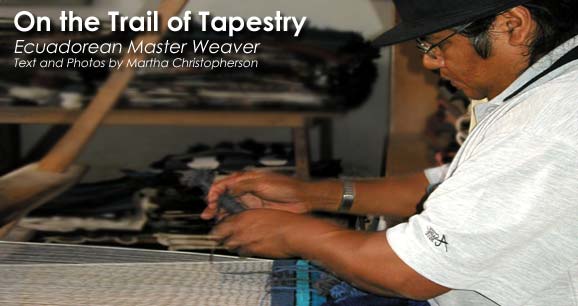
 A worn-out pickup truck with a wide-eyed pig in the back sputters past my husband and me as we stand on the corner surveying the flurry of activity in the street of Otavalo, a largely indigenous town about 37 miles (59 km) north of Ecuador’s capital.
A worn-out pickup truck with a wide-eyed pig in the back sputters past my husband and me as we stand on the corner surveying the flurry of activity in the street of Otavalo, a largely indigenous town about 37 miles (59 km) north of Ecuador’s capital.
From Quito to Otavalo it is about a two-hour drive along the Pan-American Highway, a system of roadways extending from Alaska to Chile. The stretch leading to Otavalo is a well-paved two-lane road. Buses, shuttling day-trippers from surrounding towns, deposit passengers. Taxis buzz in constant procession as they drop off locals with large, empty nylon bags.
It is Saturday, the biggest market day of the week, when fresh produce, grains, spices and even live animals are for sale. But the main attraction that brings hundreds of people to this renowned market is the handicrafts made by local artisans. (Read more on brand design tips)
Vendors set up along every street leading into the main plaza. Hundreds of sweaters, ponchos, tablecloths and tapestries in brightly woven designs hang on display. Block after block is lined with booths and tables piled high with dolls, knitted hats, alpaca scarves, mittens, finger puppets and woven bags. Other tables glisten with silver and beaded jewelry, as well as pottery and wood carvings.
The Indians of Otavalo are some of the most noted artisans in the country, and have been producing weavings since pre-Inca times using techniques handed down through the generations.
Before we threw ourselves into the lively mix of folklore, culture and bustling activity, we had breakfast at the Hotel Ali Shungu, owned and operated by an American expatriate couple, Frank Kiefer and Margaret Goodhart. The walls of the in-house restaurant were decorated with masks, watercolors and dolls. We especially noticed weavings embroidered with “José C.” in the bottom left corner.
“Who’s José C.?” I asked.
José Cotacachi is a master weaver and designer with a studio and gallery in Peguche, a town about 2.5 miles (4 km) from Otavalo, our hostess explained as she removed one of the tapestries from the wall and gave us a quick lesson on what makes a quality weaving.
“See how this weaving has no visible threads running vertically through the piece?” she asked, as we leaned in to inspect the diamond pattern. “A good, tight weave is what you want,” she says. “Good-quality yarn and a skilled master weaver make the difference.”
She also warned us that José C.’s studio gets mentioned on many tourist maps and in guidebooks, so, to keep up with the demand, other master weavers from the Andean region now do much of the weaving that eventually ends up with an embroidered José C. signature.
“They are still José C. designs, though,” she said.
With our weaving lesson stored in memory, we headed for the market plaza. After buying sweaters, alpaca scarves and handmade jewelry, we made the short drive to Peguche to check out José Cotacachi’s gallery.
Inside the two-story stuccoed structure, every inch of wall space is covered by weavings of all sizes and designs in rich colors, much richer than the tapestries sold at the market.
A weaver in the traditional costume of Otavaleño men — white pants, poncho, sandals and black felt hat — is quietly at work at a large treadle loom. We ask if he is José. He peers through his glasses, smiles and nods. He is swiftly weaving blue yarn through vertical threads that will become a 15-by-40-inch (38-by-102 cm) tapestry, which will take four to five days to complete.
Many of the tapestries on display have contemporary designs reflecting José’s innovative style. Original designs include weavings with nontraditional motifs such as fish, cats and turtles. He also works three-dimensional elements into his tapestries, for example, by attaching braided “ponytails” to the heads of women depicted in weavings so that they protrude from the piece.
These weavings are better quality than those being sold in the market — and more expensive. We buy a small, square tapestry depicting three women of Otavalo, in traditional shawls and hats, sitting on the ground.
As we drive the dirt roads of Peguche back to the highway, we pause at a stop sign. Through the open window of the rental car I can hear the unmistakable sound of the humming and clicking of electric looms hard at work in an adjacent building. It’s a reminder that automation is becoming more common in this region as the weaving industry continues to prosper.
The visit to José’s gallery means even more to me as I clutch my shopping bag and feel a sense of joy that the tapestry I now own is not just a weaving, but a piece of art signed by the artist.
If You Go
Ecuador Tourism
www.vivecuador.com
Otavalo Tourism
www.ecuadorexplorer.com/html/otavalo
- Travel Guide to Colorado - April 26, 2024
- Travel Guide to Croatia - April 26, 2024
- Top 10 Things to Do in Ireland - April 25, 2024
